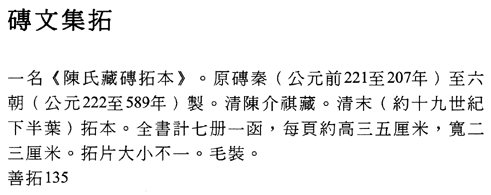 |
|
|
 |
Collected
Rubbings of Stamped Bricks with Inscriptions Qin
dynasty (221�207 b.c.e.) through
Six Dynasties period (222�589), variously dated and undated pieces Album
of 28 leaves from a set of 7 albums, ink rubbed on paper; each leaf: approx.
35.0 x 23.0 cm; dimensions of individual rubbings vary; rough-edged binding Date
of rubbings not given, late Qing dynasty (1644�1911), ca. second half of 19th
century Inventory number: Shanta 135 The
earliest bricks with inscriptions appeared during the Warring States period
(ca. 470�221 b.c.e.).� Initially the majority of inscriptions on
the bricks were stamped, with only a small number having been manually incised.� Because very few characters were used, as
was the case with inscriptions on tiles and earthenware vessels from the same
period, they were once all known as tao wen (inscriptions on
earthenware).� After the reign of
Emperor Wudi (r. 141-87 b.c.e.)
of the Western Han (206 b.c.e.�C.E.9),
the inscription contents on bricks became more and more rich; their formal
appearance was also liberated from the constraints of the xi yin shi (carved-seal
style) of earthenware inscriptions, allowing the establishment of a unique
artistic manner.� In the Eastern Han
period (206 b.c.e.�9 c.e.) bricks with inscriptions spread
from the Shaanxi area to the North China Plain and the Jiangnan region. Bricks
with inscriptions not only provide scholars of history, archaelogy, epigraphy,
and calligraphy with reliable and invaluable records but constitute a body of
ancient inscribed sources as important as writings found on oracle bones,
bronze vessels and instruments, carved seals, and stone surfaces.� This album of rubbings of bricks with
inscriptions once belonged to the collector Chen Jieqi (1813�84). |
 |